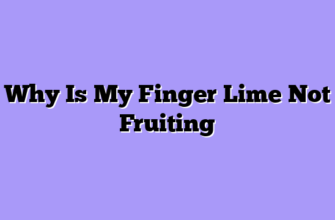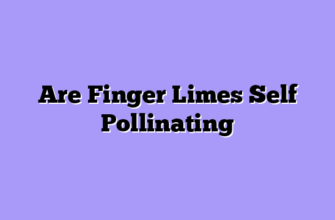When I first started growing finger limes twenty-five years ago, I thought soil was just dirt. Boy, was I wrong! After losing my first dozen Citrus australasica trees to what I now know were completely preventable soil-related issues, I learned that these Australian natives – whether you call them caviar limes, lime caviar, bush limes, or native finger limes – are incredibly particular about their growing medium. The soil beneath your feet isn’t just where these plants live; it’s the foundation of everything that makes those precious little pearls burst with flavor.
Think of soil as the stomach of your finger lime tree. Just like you wouldn’t feed a racehorse the same diet as a draft horse, you can’t expect these delicate Australian beauties to thrive in the same heavy clay that might work fine for your lemon trees. I’ve spent decades perfecting soil mixtures, testing pH levels, and watching how different soil compositions affect everything from root development to vesicle formation in the fruit.
The journey hasn’t been easy. My first attempt at growing these “green caviar” gems ended in disaster when I planted them in standard garden soil. Within six months, I had root rot, yellowing leaves, and trees that looked like they were begging me to put them out of their misery. That expensive lesson taught me that finger limes demand respect – especially when it comes to their soil requirements.
Understanding the Native Habitat: Lessons from Down Under
To truly understand what Citrus australasica needs, you have to think like the plant. In their native Australian habitat, these bush limes grow naturally in the well-draining, slightly acidic soils of rainforest margins and creek banks. We’re talking about loose, organic-rich earth that never stays soggy but never completely dries out either.
I’ve studied soil samples from native finger lime habitats in Queensland and New South Wales, and the pattern is consistent: sandy loam with high organic content, excellent drainage, and a pH between 5.5 and 6.5. The soil structure is loose and friable – you can literally crumble it in your hands like good chocolate cake mix.

During my research trip to Australia in 2019, I met Dr. Sarah Chen, a soil scientist at the University of Queensland who’s been studying native finger lime habitats for over a decade. She told me something that completely changed my approach: “These plants aren’t looking for a banquet – they want a steady, balanced meal in a comfortable dining room.”
My Soil Recipe: Twenty-Five Years of Trial and Refinement
After countless experiments, soil tests, and yes, plenty of dead trees, I’ve developed what I call my “Australian Dreams” soil mix. This blend has consistently produced healthy, productive finger lime trees across different climate zones and growing conditions.
Base Components (by volume):
- 40% quality potting soil (well-composted, disease-free)
- 30% coarse perlite (for drainage and aeration)
- 20% aged pine bark fines (organic matter and structure)
- 10% coarse sand (not fine sand – that creates concrete!)
Amendments per cubic yard:
- 2 pounds kelp meal (slow-release minerals)
- 1 pound rock phosphate (long-term phosphorus)
- 4 pounds aged chicken manure compost
- 1 pound gypsum (calcium without raising pH)
The magic happens in the ratios and the quality of each component. I’ve tried cheaper substitutions over the years, and trust me, it’s not worth the savings. Quality perlite costs more than the chunky white stuff you find at big box stores, but it makes all the difference in root development.
| Soil Component | Purpose | Quality Indicators | Common Mistakes |
|---|---|---|---|
| Potting Soil | Base nutrition, water retention | Dark, crumbly, earthy smell | Using garden soil (too heavy) |
| Perlite | Drainage, aeration | Large chunks, bright white | Fine perlite (poor drainage) |
| Pine Bark | Organic matter, structure | Aged 6+ months, uniform size | Fresh bark (nitrogen tie-up) |
| Coarse Sand | Drainage, root penetration | Angular particles, varied sizes | Fine sand (creates hardpan) |
The kelp meal is my secret weapon. I discovered its benefits by accident when a shipment of regular fertilizer was delayed, and I used kelp meal as a temporary substitute. The results were remarkable – better root development, improved disease resistance, and noticeably more flavorful fruit. Now it’s a permanent part of my soil recipe.
pH and Drainage: The Critical Balance
If I had to choose the two most important factors for finger lime soil success, it would be pH and drainage. Get these wrong, and nothing else matters. I’ve seen beautiful, expensive trees die within months because growers ignored these fundamentals.
pH Management: Finger limes prefer slightly acidic conditions, with an optimal pH range of 5.8 to 6.5. This isn’t just a preference – it’s a nutritional necessity. At pH levels above 7.0, these plants can’t efficiently absorb iron, manganese, and other micronutrients, leading to chlorosis and poor growth.
I test pH religiously, both in my soil mixes and in established plantings. I use a combination of digital pH meters for quick checks and professional lab analysis for detailed soil chemistry. The investment in proper testing equipment pays for itself quickly when you consider the cost of replacing dead trees.
Here’s a trick I learned from an old citrus grower in Florida: I add sulfur to lower pH gradually rather than using quick-fix acidifiers. Elemental sulfur works slowly through bacterial action, creating stable, long-term pH conditions. I typically add 1-2 pounds of sulfur per cubic yard of soil mix, depending on the starting pH.
Drainage Dynamics: Poor drainage kills more finger limes than any pest or disease. These plants absolutely cannot tolerate waterlogged conditions. I’ve learned to think of drainage in three dimensions: surface drainage, internal drainage, and deep drainage.
Surface drainage prevents water from pooling around the trunk. I always plant finger limes on raised beds or mounds, even in well-draining soils. The crown of the tree should be 4-6 inches above the surrounding soil level.
Internal drainage is about soil structure. This is where the perlite and coarse sand in my mix earn their keep. The soil should drain quickly but still hold enough moisture for consistent root access. I use the “squeeze test” – a handful of moist soil should hold together when squeezed but crumble easily when disturbed.
Deep drainage prevents water table problems and salt accumulation. I always check drainage at the 18-24 inch depth before planting. If water stands in a test hole at this depth for more than 24 hours after heavy rain, I install drainage tile or choose a different location.
Container Growing: Soil Considerations for Potted Caviar Limes
About 40% of my finger lime production now happens in containers, and the soil requirements are even more critical in pots. Container-grown lime caviar trees can’t extend their roots to find better soil conditions, so every cubic inch of growing medium matters.
My container mix is more aggressive than my in-ground recipe:
- 35% high-quality potting mix (coir-based, not peat)
- 35% coarse perlite (drainage is critical in containers)
- 20% aged pine bark fines (organic matter and structure)
- 10% pumice or expanded shale (long-term drainage)
The key difference is the increased drainage components. Container soil should drain quickly but never become hydrophobic. I’ve found that coir-based potting mixes work better than peat-based ones for finger limes because coir doesn’t become as water-repellent when it dries out.
Container size matters enormously. I’ve learned that finger limes need room to develop their naturally spreading root system. My minimum container size is 25 gallons for mature trees, though I prefer 50-gallon containers when space allows. Small pots create root-bound conditions that stress the trees and reduce fruit quality.
Container Soil Monitoring: Container-grown plants require more intensive soil management. I check soil moisture daily during growing season and test soil pH monthly. Container soils tend to become more acidic over time as organic matter decomposes, so I often need to add lime to maintain optimal pH.
I also flush container soils monthly with clear water to prevent salt buildup from fertilizers. This is especially important in areas with hard water or when using synthetic fertilizers regularly.
Soil Amendments and Long-Term Health
Building great finger lime soil isn’t a one-time project – it’s an ongoing relationship. I’ve learned that these Australian natives respond beautifully to consistent, gentle soil improvement rather than dramatic interventions.
Organic Matter Management: I add compost to my finger lime beds twice yearly – once in early spring and again in fall. But not just any compost will do. I’ve found that mushroom compost works exceptionally well, probably because of its balanced carbon-to-nitrogen ratio and excellent soil structure benefits.
The composted chicken manure I mentioned earlier serves a dual purpose. Beyond nutrition, it dramatically improves soil biology. Healthy soil microbiology is crucial for finger lime root health, and these trees seem to form beneficial relationships with mycorrhizal fungi more readily in biologically active soils.
Mulching Strategy: Proper mulching is like insurance for your soil investment. I use a 3-4 inch layer of aged wood chips, keeping the mulch 6 inches away from the trunk to prevent pest issues. The mulch gradually decomposes, adding organic matter while maintaining consistent soil temperature and moisture.
Here’s something most growers miss: the type of wood chips matters. I prefer hardwood chips over softwood because they decompose more slowly and don’t tie up soil nitrogen as aggressively. Pine chips can work, but they need to be well-aged to prevent nitrogen competition.
Soil Testing and Monitoring Protocol: I conduct comprehensive soil analysis annually, usually in late winter before the growing season begins. This timing gives me a baseline before adding any amendments or fertilizers. I test for:
| Test Parameter | Optimal Range | Action Needed | Frequency |
|---|---|---|---|
| pH | 5.8-6.5 | Adjust with sulfur/lime | Monthly quick test, annual lab |
| Organic Matter | 4-8% | Add compost if below 4% | Annual |
| Electrical Conductivity | <2.0 dS/m | Flush soil if higher | Quarterly |
| Phosphorus | 30-60 ppm | Adjust fertilization | Annual |
| Potassium | 150-300 ppm | Adjust fertilization | Annual |
| Calcium/Magnesium Ratio | 3:1 to 5:1 | Add gypsum or Epsom salt | Annual |
The electrical conductivity test is particularly important in areas with hard water or heavy fertilizer use. Finger limes are sensitive to salt accumulation, and I’ve seen healthy trees decline rapidly when salt levels creep up unnoticed.
Troubleshooting Common Soil Problems
Even with the best intentions, soil problems can develop. I’ve become pretty good at diagnosing issues based on plant symptoms and soil conditions. Here are the most common problems I encounter and my solutions:
Compacted Soil: Symptoms include slow growth, yellowing leaves, and poor fruit development. Solution: Core aeration followed by top-dressing with compost and perlite mixture.
pH Drift: Usually shows up as iron chlorosis (yellowing between leaf veins) or general decline. Solution: Gradual pH adjustment using sulfur or lime, depending on direction needed.
Salt Accumulation: Manifests as brown leaf margins and stunted growth. Solution: Deep watering to flush salts, followed by improved drainage and reduced fertilizer rates.
Poor Drainage: Root rot, fungal issues, and tree decline. Solution: Installation of drainage systems or relocation to raised beds.
Nutrient Lockup: Often caused by pH problems or antagonistic nutrient interactions. Solution: Soil testing to identify the issue, followed by targeted amendments.
The key to successful soil management for finger limes is consistency and patience. These plants reward steady, thoughtful care rather than dramatic interventions. Think of yourself as a soil steward rather than a soil manager – your job is to create and maintain conditions where these remarkable Australian natives can express their full potential.
After twenty-five years of growing caviar limes, I’m still learning new things about soil management. Each growing season brings new challenges and opportunities to refine my approach. But the fundamentals never change: well-draining, slightly acidic soil with good organic content and proper structure. Get these basics right, and your finger limes will reward you with years of productive, flavorful harvests that capture the essence of their Australian heritage.








